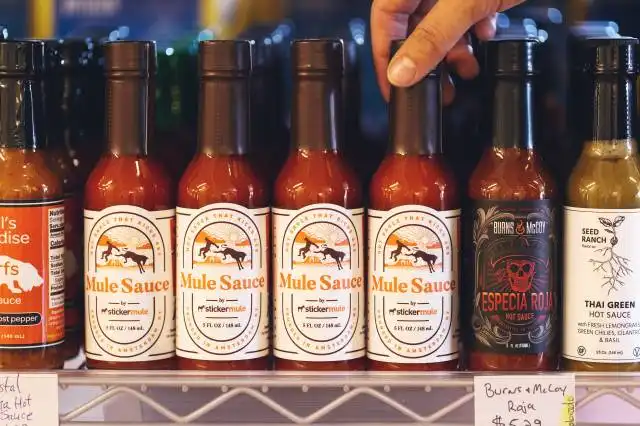Start a Convenience Store
Becoming the Neighborhood's Superhero: Launch Your Own Convenience Store
| Updated


CONVENIENCE STORE
Step into the dynamic world of convenience store ownership, where late night snack attacks and last-minute household needs become your opportunity for profit! This venture sees you managing a small retail business that provides an array of everyday items to your local community. From bread and milk to toilet paper and, of course, candy - your store will be the neighborhood superhero, saving the day one grocery item at a time. It's a hands-on business, perfect for those who love multitasking, meeting people and making a difference in a fast-paced environment.
Jump to Business Plan
RELATED BUSINESS IDEAS
Browse ALL Food & Beverage Entrepreneurship Business Ideas
Discover Your Perfect Domain
Unlock the door to your online success with our hand-picked selection of premium domain names. Whether you're starting a new venture or rebranding an existing one, the right domain can set the tone for your digital presence. Browse through our curated list, each with its unique potential to enhance your brand's visibility and credibility.
CONVENIENCE STORE MINI BUSINESS PLAN
This a quick reality check to help you identify the strengths and weaknesses of your business concept before you dive in.
Convenience Store Business Quick Facts
Expected Profit Margins
- Gross Margin: Typically around 20% – 35%
- Net Profit Margin: Usually between 1% - 6%
Earnings Expectations:
- Daily Earnings: Expected at around $200 - $700 depending on location and size
- Weekly Earnings: Will range from $1,400 - $4,900
- Monthly Earnings: You can expect about $6,000 - $21,000
- Annual Earnings: A standard prediction is between $72,000 - $250,000
Actions Required to Reach These Profit Targets
Inventory Management
- Begin with an Initial Investment in inventory: likely between $20,000 - $50,000
- Develop a strong Supplier Network: Cultivate relationships with reliable suppliers.
Marketing & Customer Acquisition
- Establish a consistent Social Media presence: Post 2 - 3 times per week on your desired social platform(s).
- Consider Local Advertising: Invest a reasonable portion of your budget in local avenues such as newspaper ads.
Sales & Customer Handling
- Consider hiring Staff: At least 2-3 full-time employees to ensure smooth store operations.
- Provide excellent Customer Service. Strong service drives customer loyalty and repeat business.
Cost Control
- Keep Rent in mind: Your location budget should be less than 10% of your expected monthly sales.
- Utilities and Maintenance: Budget for between $400-$600 monthly for this category.
General Business Operations
- Decide on your Opening Hours: Convenience stores typically operate between 12-24 hours.
- Aim to handle an average of 50-150 transactions per day with an average transaction value of $10 - $20.
Please note: All these factors depend greatly on elements like size, location, and economic climate. Always consider performing a detailed financial scrutiny and seeking expert consultation for a tailored financial plan.
NOT WHAT YOU HAD IN MIND? Here are more ideas



Browse ALL Food & Beverage Entrepreneurship Business Ideas
Grab Your Business Website Name
Before you get caught up in the whirlwind of setting up your business, invest in a domain name. It's a small but significant step that lays the foundation for your brand and makes it easier for customers to find and trust you. Just like you wouldn't build a house without securing the land first, don't build a business without securing your domain name.
"Why? Can't that wait?" Here's why it shouldn't
Step 1: Determine if the Business is Right for You
Breakdown of Startup Expenses
Before starting a convenience store, it is important to understand the startup costs associated with the business. These costs can include the cost of the building, the cost of the inventory, the cost of the equipment, the cost of the staff, and any other costs associated with the business. It is important to take into account all of these costs before starting a convenience store. Additionally, it is important to research the local market to determine the competition and the potential for success.
Breakdown of Ongoing Expenses
Once the startup costs have been determined, it is important to understand the ongoing expenses associated with running a convenience store. These expenses can include the cost of the inventory, the cost of the staff, the cost of the utilities, the cost of the advertising, and any other costs associated with the business. It is important to take into account all of these costs when determining the potential profitability of the business.
Examples on Ways to Make Money
There are a variety of ways to make money with a convenience store. These can include selling snacks and beverages, selling cigarettes and other tobacco products, selling lottery tickets, offering money transfer services, and offering other services such as ATM machines. Additionally, it is important to consider the potential for offering additional services such as car washes, gas stations, and other services that can be offered in the convenience store. It is important to research the local market to determine the potential for success with these services.
Step 2: Name the Business
When naming your convenience store, it is important to choose a name that is memorable and easy to pronounce. Additionally, it should be unique and not too similar to other convenience stores in the area. You should also consider the potential for future expansion and growth when selecting a name. It is also important to consider the potential for trademarking the name, as this will help protect your business from competitors. Additionally, you should consider the potential for creating a logo or tagline that can be used to help promote the business. Finally, you should also consider the potential for creating a website or social media presence for the business. This can help you reach a larger audience and create a more professional presence.
Step 3: Secure Financing
The third step in starting a convenience store is to secure financing. There are a variety of sources of financing available to entrepreneurs, including traditional bank loans, venture capital, and angel investors. When considering which type of financing to pursue, it is important to consider the amount of money needed, the terms of the loan, and the repayment schedule. It is also important to consider the risk associated with each type of financing.
Business Plan
In order to secure financing, it is important to create a business plan. A business plan should include an executive summary, a description of the business, a market analysis, a competitive analysis, a description of the products and services offered, a financial plan, and a marketing plan. The business plan should be comprehensive and well-researched, and should be tailored to the specific needs of the business.
Financial Projections
In addition to the business plan, it is important to create financial projections. Financial projections should include an income statement, a balance sheet, and a cash flow statement. These projections should be based on realistic assumptions about the business and should be updated regularly.
Loan Application
Once the business plan and financial projections have been created, it is time to apply for a loan. The loan application should include the business plan, financial projections, and any other relevant information. It is important to be honest and accurate when filling out the loan application, as lenders will be looking for evidence that the business is viable and that the entrepreneur is capable of managing the business.
Step 4: Find a Location
When choosing a location for a convenience store, there are several factors to consider. First, the location should be easily accessible to customers. It should be located in a high-traffic area, such as a busy street or near a shopping center. Additionally, the location should be in a safe area with plenty of parking. It should also be in an area with a large population of potential customers.
Leasing vs. Buying
When it comes to finding a location, you have the option to either lease or buy the property. Leasing can be beneficial because it requires less upfront capital and allows for more flexibility. However, buying a property can be beneficial in the long run, as it gives you the opportunity to build equity and potentially increase the value of the property.
Research Local Regulations
Before selecting a location, it is important to research local regulations. Different cities and states have different regulations regarding the operation of a convenience store. It is important to understand the regulations and ensure that the store is compliant with all laws. Additionally, it is important to research any zoning regulations that may be in place.
Negotiate a Lease
Once you have found a location, it is important to negotiate a lease. When negotiating a lease, it is important to understand the terms and conditions of the lease and ensure that they are favorable to you. Additionally, it is important to negotiate a reasonable rent amount and to ensure that the lease is for a reasonable length of time.
Step 5: Obtain Licenses and Permits
When starting a convenience store, there are a variety of licenses and permits that must be obtained. Depending on the state and local regulations, these may include a business license, a food service license, a tobacco license, a liquor license, and a sales tax permit. It is important to research the specific regulations in the area to ensure that all the necessary licenses and permits are obtained.
How to Obtain Licenses and Permits
In order to obtain the necessary licenses and permits, it is important to contact the local government offices to determine the exact requirements. This may include submitting an application, providing proof of insurance, and paying any applicable fees. Additionally, some licenses and permits may require additional steps such as inspections or background checks. Once all the necessary paperwork is completed and the fees are paid, the licenses and permits will be issued.
Cost of Licenses and Permits
The cost of licenses and permits can vary greatly depending on the area and the type of license or permit being obtained. Generally, the cost of a business license is relatively low, while the cost of a food service license or a liquor license can be much higher. Additionally, some permits may require an annual fee in order to maintain them.
Benefits of Obtaining Licenses and Permits
Obtaining the necessary licenses and permits is important to ensure that the business is operating legally. Additionally, having the proper licenses and permits can help to establish credibility with customers, suppliers, and other businesses. Furthermore, having the proper licenses and permits can help to protect the business from potential legal issues.
Step 6: Purchase Equipment
When starting a convenience store, there are several types of equipment that will be needed. These include refrigerators, freezers, shelving, cash registers, and point-of-sale systems. Additionally, depending on the type of store, other equipment such as microwaves, ovens, and grills may be necessary. It is important to research the types of equipment that are necessary for the specific type of store being opened.
Where to Purchase Equipment
When purchasing equipment for a convenience store, there are several options. The first option is to purchase new equipment from a local supplier. This is often the most expensive option, but it can be beneficial if the equipment is of high quality and will last for many years. Another option is to purchase used equipment from a local supplier or online. This can be a more cost-effective option, but it is important to make sure the equipment is in good condition and will last for a long time. Finally, some stores may choose to lease equipment from a supplier. This can be a great option for those who are on a tight budget and need to save money in the short-term.
Step 7: Hire Employees
When hiring employees, it is important to consider the type of employees you need. Do you need full-time or part-time employees? Do you need employees with specific skills or experience? It is important to consider the cost of hiring employees and the cost of training them. Additionally, it is important to consider the legal requirements for hiring employees, such as background checks, taxes, and insurance.
Benefits of Hiring Employees
Hiring employees can be beneficial to a convenience store business. Employees can help with customer service, stocking shelves, and cleaning. Employees can also help with marketing and advertising, as well as with the day-to-day operations of the store. Additionally, having employees can help to create a sense of community and loyalty among customers.
Training Employees
Once you have hired employees, it is important to provide them with proper training. Training should include customer service, safety protocols, and store policies. Additionally, it is important to provide employees with the necessary tools and resources they need to do their job. This could include a manual or training videos.
Employee Retention
Employee retention is an important part of running a successful convenience store. It is important to provide employees with competitive wages and benefits, as well as a positive work environment. Additionally, it is important to recognize and reward employees for their hard work. This could include bonuses, promotions, or other incentives. Finally, it is important to provide employees with opportunities for growth and development. This could include additional training or educational opportunities.
Step 8: Market Your Business
Now that you have your business up and running, it's time to get the word out. There are a variety of ways to market your business, and it's important to find the right combination that works for you. Examples of ways to market your business include:
- Social media: Utilizing social media platforms like Facebook, Twitter, and Instagram to reach potential customers is a great way to get the word out about your business. You can post about special deals and promotions, as well as share photos and videos of your store.
- Local advertising: Advertising in local newspapers and magazines is a great way to reach potential customers in your area. You can also consider radio and television advertising, as well as direct mail campaigns.
- Networking: Networking with other local businesses is a great way to get the word out about your business. You can join local business associations, attend trade shows, and even sponsor local events.
- Word of mouth: Word of mouth is one of the most powerful forms of marketing. Encourage your customers to spread the word about your business by offering incentives such as discounts or freebies.
Tips for Effective Marketing
In addition to the examples above, here are some tips for effective marketing:
- Have a clear message: Make sure your message is clear and concise so that potential customers can easily understand what your business is about.
- Focus on your target audience: Identify your target audience and tailor your marketing efforts to reach them.
- Track your results: Track the results of your marketing efforts so that you can adjust your strategy as needed.
- Be consistent: Consistency is key when it comes to marketing. Make sure you are consistent in your messaging and branding across all platforms.
- Have fun: Don't be afraid to have fun with your marketing efforts. Get creative and come up with unique ideas that will help you stand out from the competition.
Step 9: Open for Business
Opening day is the culmination of all the hard work that has gone into starting a convenience store. To ensure a successful opening day, there are a few things that should be done. First, make sure to have plenty of staff on hand to help customers and keep the store running smoothly. It is also important to have plenty of promotional materials available, such as flyers and coupons, to draw in customers. Additionally, it is important to have all the necessary supplies ready, such as food, drinks, and other items. Finally, make sure to have a grand opening event to celebrate the new store and to draw in even more customers.
Ongoing Maintenance
Once the store is open, it is important to maintain it properly. This includes stocking shelves, cleaning the store, and managing inventory. Additionally, it is important to keep up with marketing efforts to draw in new customers and keep existing customers coming back. It is also important to keep up with customer service, as this will help ensure customers have a positive experience in the store. Finally, it is important to stay up to date with industry trends and changes, as this can help the store stay competitive and profitable.
EXPLORE MORE CATEGORIES
Browse ALL Business Idea Categories
TAKE THE NEXT STEPS










